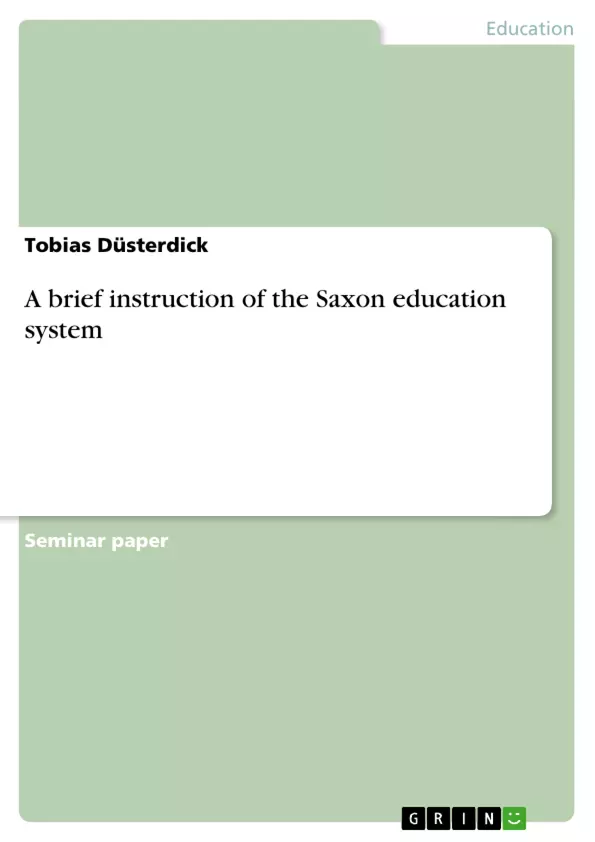Already the German philosopher Immanuel Kant (1724-1804) said: “Saupere aude – Habe Mut dich deines eigenen Verstandes zu bedienen”(“Be brave to use your own mind”). But for this an extensive education is necessarily. This fact underlines the importance of a well-functioning education system. A great amount of approaches all over the world toward this topic exits and this essays aim is to present the Saxon one.
To achieve this, the essay will start with structure of the education system of Saxony. This contains, among other information, the learning-aims, achievable graduations and selectable profiles of elementary schools, secondary schools, academic high schools, and schools for gifted pupils as well as schools for pupils with special needs. In this context the function of the orientation classes will be also explained. Subsequently the administrative structure of the Saxon education systems will be presented. This includes important tasks of the Minister of educational and cultural affairs as well as his ministry, the 5 subordinate education authorities and the structure of 2 last mentioned. The tasks and qualification of headmasters will be particularly emphasised in order to underline their importance for the Saxon education system. Based on this the significant findings of the “Programme for International Student Assessment” 2006 (PISA) as well as of the “Bildungsmonitor” 2010 will be presented. In conclusion all important facts will be summarized. If current challenges and priorities are traceable in an area will these constitute in the end of a chapter.
Inhaltsverzeichnis (Table of Contents)
- Introduction
- The structure of the Saxon education-system
- The elementary school
- The orientation classes
- The secondary school
- The academic high school
- Schools for gifted pupils
- Schools for pupils with special needs
Zielsetzung und Themenschwerpunkte (Objectives and Key Themes)
This essay provides a comprehensive overview of the Saxon education system, focusing on its structure, administration, and challenges. The goal is to shed light on the organization and functioning of the system, examining the various types of schools, educational pathways, and the challenges faced in implementing educational reforms.
- Structure and organization of the Saxon education system
- Educational pathways and graduation options
- Administrative framework and roles of key personnel
- Challenges of implementing educational reforms
- Performance and effectiveness of the system, particularly in light of international assessments
Zusammenfassung der Kapitel (Chapter Summaries)
The essay begins with an introduction outlining the importance of well-functioning education systems and the goal of presenting the Saxon model. It then delves into the structure of the Saxon education system, describing the different types of schools and their aims, including elementary schools, secondary schools, academic high schools, and schools for gifted and special needs pupils. This section also explains the function of orientation classes.
Following this, the essay discusses the administrative structure of the Saxon education system, highlighting the roles and responsibilities of the Ministry of Education and Cultural Affairs, the subordinate education authorities, and headmasters. The chapter then examines the results of international assessments such as PISA and Bildungsmonitor, shedding light on the strengths and weaknesses of the Saxon education system.
Schlüsselwörter (Keywords)
The Saxon education system, school structure, elementary schools, secondary schools, academic high schools, orientation classes, administrative structure, Ministry of Education and Cultural Affairs, educational reforms, PISA, Bildungsmonitor, challenges, priorities.
- Quote paper
- Tobias Düsterdick (Author), 2011, A brief instruction of the Saxon education system , Munich, GRIN Verlag, https://www.grin.com/document/190895



